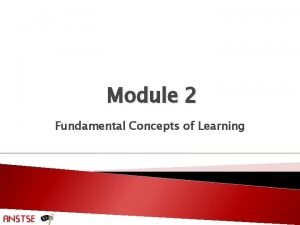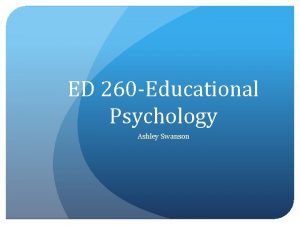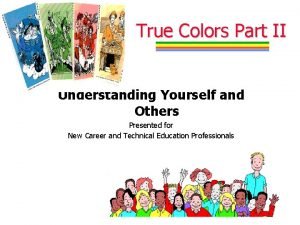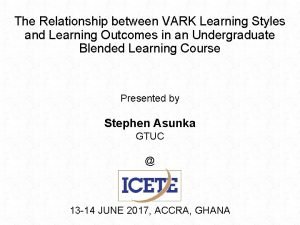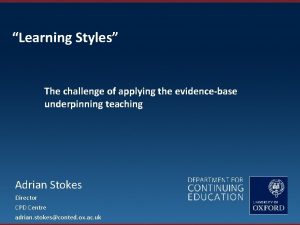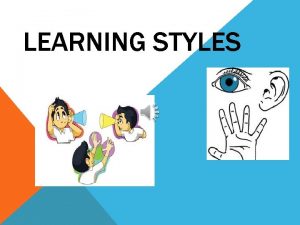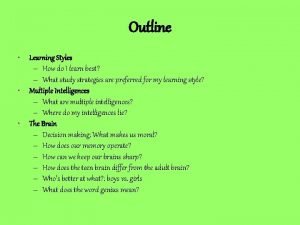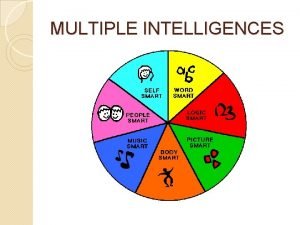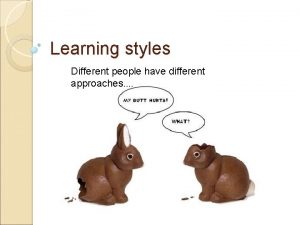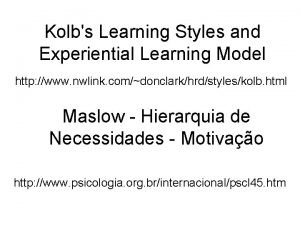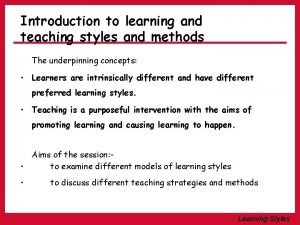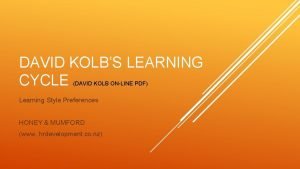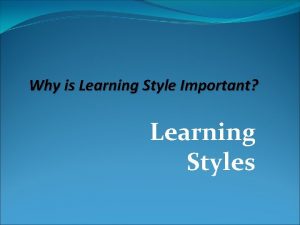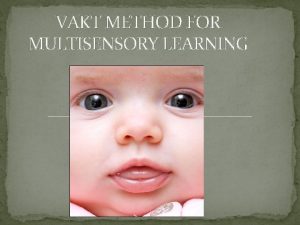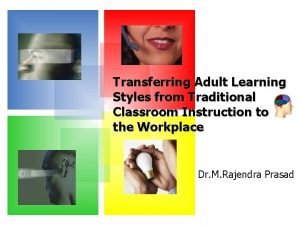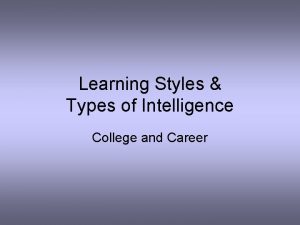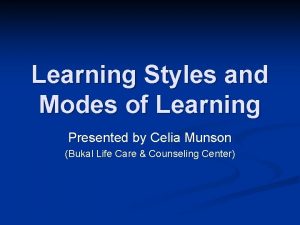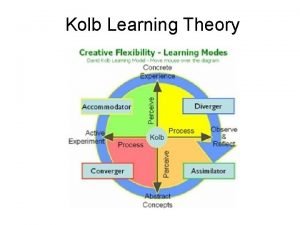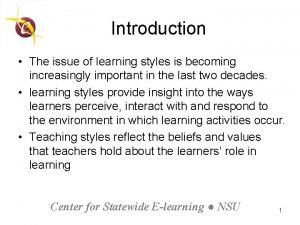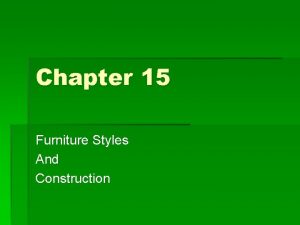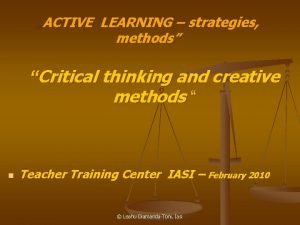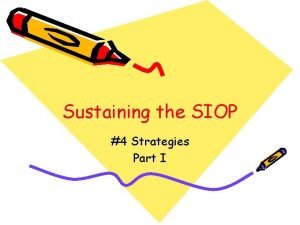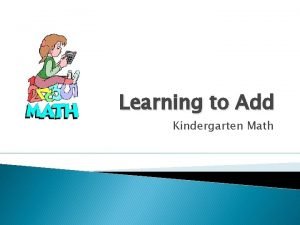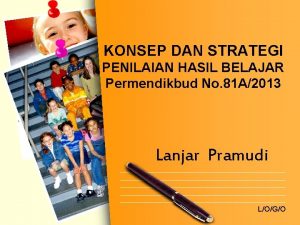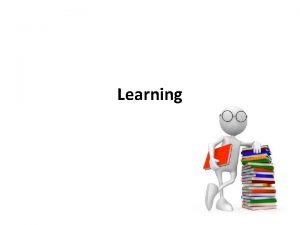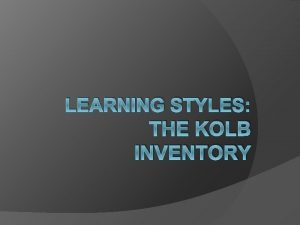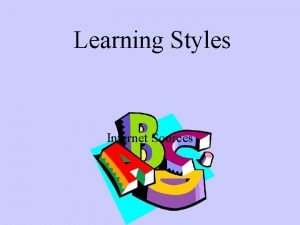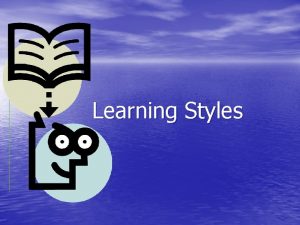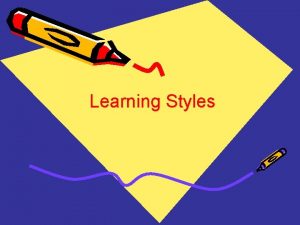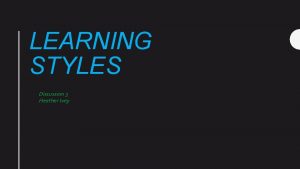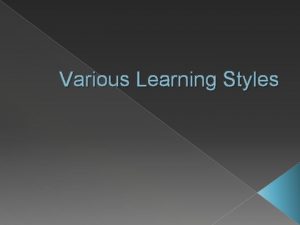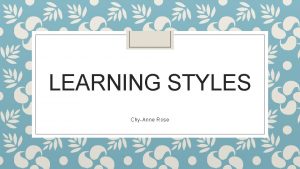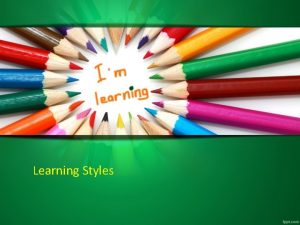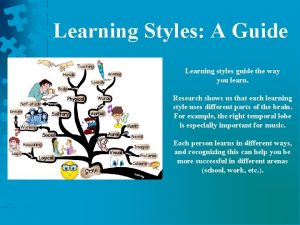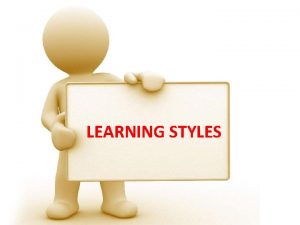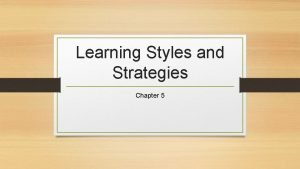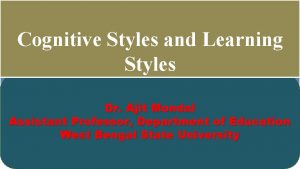Learning Styles and Strategies Chapter 5 Section 1





































- Slides: 37

Learning Styles and Strategies Chapter 5

Section 1: The Learning Process • • • By the end of this section, you will be able to: Identify the stages of the learning process Define learning styles, and identify your preferred learning style(s) Define multimodal learning Describe how you might apply your preferred learning strategies to classroom scenarios

The Learning Process • Stages of the Learning Process • Consider experiences you’ve had with learning something new, such • • as learning to tie your shoes or drive a car. You probably began by showing interest in the process, and after some struggling it became second nature. These experiences were all part of the learning process, which can be described in the four stages: Unconscious incompetence – Showing interest in a talent or skill Conscious incompetence – Realize how much you have to learn Conscious competence – Beginning to master your goals; feeling confident Unconscious competence – Able to do the task without thinking about it

The Learning Process • Take a moment to watch the following video by Kristos called The Process of Learning. As you watch, consider how painful it can be —literally!—to learn something new, but also how much joy can be experienced after it’s learned. Note that the video has no audio. • https: //youtu. be/G 1 e. Q 6 JWAi 9 Q

The Learning Process VARK Assessment • • • Neil Fleming’s VARK model includes four modalities: Visual learning Auditory learning Read/write learning Kinesthetic learning

VARK • Fleming claimed that visual learners have a preference for seeing (visual aids that represent ideas using methods other than words, such as graphs, charts, diagrams, symbols, etc. ). • Auditory learners best learn through listening (lectures, discussions, tapes, etc. ). • Read/write learners have a preference for written words (readings, dictionaries, reference works, research, etc. ) • Tactile/kinesthetic learners prefer to learn via experience—moving, touching, and doing (active exploration of the world, science projects, experiments, etc. ).

Multimodal Learning • While completing the learning-styles activity, you might have discovered that you prefer more than one learning style. Applying more than one learning style is known as multimodal learning. This strategy is useful not only for students who prefer to combine learning styles but also for those who may not know which learning style works best for them. It’s also a good way to mix things up and keep learning fun. • For example, consider how you might combine visual, auditory, and kinesthetic learning styles to a biology class. For visual learning, you could create flash cards containing images of individual animals and the species name. For auditory learning, you could have a friend quiz you on the flash cards. For kinesthetic learning, you could move the flash cards around on a board to show a food web (food chain).

Multimodal Learning • The following video will help you review the types of learning styles and see how they might relate to your study habits: • https: //youtu. be/dv. Mex 7 KXLv. M

VARK – What is your learning preference? • Identify your learning style by taking the VARK questionnaire that is located in The Learning Process section of your book. • Complete the reflection form over your VARK assessment and submit the form through the link provided on blackboard. (This will count as a grade) • See the due date for the VARK Reflection that is posted on the course calendar.

What is Multiple Intelligence? • Watch Battle Of The Brains at https: //vimeo. com/107250116 • Complete the multiple intelligence test found at the link provided in your course text or by clicking HERE. • What were your preferred intelligence? Complete the discussion board question regarding MI found on blackboard under the DB tab. • Complete the MI Reflection by the due date posted on the course calendar. • Review MI by playing the Kahoot found HERE.

Section 2: Class Preparation • By the end of this section, you will be able to: • Identify effective mental and physical strategies to prepare for an individual class session • Describe typical ratios of in-class to out-of-class work per credit hour

Physically and Mentally Preparing for Class • • • Eat Healthy Meals and Snacks Exercise Regularly Get Enough Sleep Manage Stress Talk to Guidance Counselors or Instructors

Class- and Study-Time Ratios • The amount of time students spend on coursework outside of the physical classroom will vary, depending on the course (how rigorous it is and how many credits it’s worth) and on the institution’s expectations. • A general rule is that the ratio of classroom time to study time is 1: 2 or 1: 3. That means that for every hour you spend in class, you should plan to spend two to three hours out of class working independently on course assignments. • For example, if your composition class meets for one hour, three times a week, you’re expected to devote from six to nine hours each week on reading assignments, writing assignments, etc.

Creating a Planner • Create a weekly planner for the entire semester. You can use your own personal planner or find one that is similar to the one I have included. Include your class schedule, work schedule, extracurricular activities, religious activities, study time, and any other important information. • • • See the sample planner in this section to help guide you. Consider the following: Start with Fixed Time Commitments Consider Your Studying and Homework Habits Plan Ahead Consider Leisure Time

Section 3: Class Attendance • • • By the end of this section, you will be able to: Explain why regular class attendance class is important Identify effective listening strategies Identify effective participation strategies Compare different note-taking strategies and assess which is most effective for you • Convert notes to study guides • Evaluate different teaching styles and how your personal learning style fit with each • Identify strategies for obtaining content from a class you missed

Why Go to Class? • • Class participation Class interaction Interaction with the instructor Increased learning

Effective Listening Strategies • focus your full attention on the speaker • ask questions, either out loud or internally, in response to what is being said • paraphrase ideas in notes • listen nonjudgmentally • show empathy for the speaker

Effective Participation Strategies • • Be a team player Share meaningful questions and comments Be prepared The resource, “How to stay focused in class: 7 tricks to avoid zoning out” found HERE can help you evaluate what you need to work on in order to participate in class more effectively.

HOW WELL DO I PARTICIPATE IN CLASS? If you saw me in class, you could describe me as: a. That person in the corner looking out the window. b. The person who monopolizes class discussions. c. The person with prepared notes and questions and ready to participate. d. None of the above.

How Well Do I Participate In Class? • IF YOU PICKED C – GIVE YOURSELF 3 POINTS

How Well Do I Participate In Class? My teacher probably thinks during class that I: a. Suffer from tendonitis since I never write anything down. b. Am the next Picasso based on all the doodling that I do. c. Wrote the textbook since I always know what it said without even opening it up. d. None of the above.

How Well Do I Participate In Class? • IF YOU PICKED D – GIVE YOURSELF 3 POINTS

How Well Do I Participate In Class? Check all that apply: a. I contribute to the discussion every week in class. b. I check my email during class. c. I could give classes in study skills since I exhibit them so well. d. I read the text five minutes before class starts for the first time.

How Well Do I Participate In Class? • IF YOU PICKED A – GIVE YOURSELF 2 POINTS • IF YOU PICKED C – GIVE YOURSELF 2 POINTS

Use the information below to see that your score really means. • 10 -8 – You’ve got the right idea! Participation is a regular part of what you do in class. This module can provide you with some additional ideas on how to participate in class and how to use different strategies and ideas to improve your participation. • 5 -7 – You’re on the right track. You may need some ideas on how to continue to get better. • 2 -4 – Uh-oh! Let’s get to work. Participation isn’t something that just happens – you need to make it happen! • 0 -1 – You’re having a class participation emergency! Take extra notes during the module so you can put these ideas to work right away.

Note-Taking Strategies • Stay organized: Keep your notes and handouts separate for each class. • Use visual cues: Try highlighting, underlining, or drawing arrows or exclamation points next to any main or difficult concepts. • Group together similar concepts: Grouping or “chunking” material is a good way to make studying and memorization easier. • Make notes legible: Some people have messy handwriting. However, writing as clearly as possible when you take notes will make it easier to review them later.

Teaching Styles (5 Types) • (1) Authority style: Instructors with an authority style of teaching prefer to give lectures while standing in front of class, often doing a combination of talking and writing information on the board. Students are expected to listen and take notes. • (2) Demonstrator style: Instructors with a demonstrator style of teaching prefer to lecture, also, but they prefer to “show” students what they’re explaining, often by using visual aids such as Powerpoint presentations, handouts, and demos.

Teaching Styles • (3) Facilitator style: Instructors with a facilitator style rely heavily on class discussion, asking students to participate a lot while they provide prompts and guiding questions. • (4) Delegator style: Instructors with a delegator approach prefer to structure their classes around student-run projects and presentations— their own teaching takes a backseat to students teaching one another. • (5) Hybrid style: Instructors with a hybrid teaching style use a combination of the learning styles above. For example, during an hourlong class session, they might schedule twenty minutes for a lecture, twenty minutes for class discussion, and twenty minutes for a class activity.

If You Need to Miss a Class • Plan in advance: Although nobody can plan to be sick, students should give their instructors advanced notice if they know they will need to miss class for something like a doctor’s appointment. • Talk to fellow students: Ask to borrow class notes from one or two classmates who are reliable note takers. Be sure to also ask them about any announcements or assignments the instructor made during the class you missed. • Do the reading assignment(s) and any other homework. Take notes on any readings to be discussed in the class you missed. If you have questions on the reading or homework, seek help from your classmates. Completing the homework and coming prepared for the next session will demonstrate to your instructor that you are still dedicated to the class. Remember that just because you are absent does not mean you get longer to do the assignment. The assignment is still due by the due date that is posted on the course calendar. Late assignments are not accepted, so be sure to get your work completed. • Check Blackboard: The course calendar is located on blackboard and will list the chapter that is schedule to be discussed for that class time. The course calendar will also list assignments that are due. The instructor will also use blackboard to post announcements so make sure to check as well as check your email for important announcements.

Section 4: The Role Of Memory • By the end of this section, you will be able to: • Describe strategies for deciding which course content to learn and retain • Differentiate between short-term and long-term memory, and describe the role of each in effective studying • Identify memory-strengthening strategies

First Exam Jennifer felt anxious about an upcoming history exam. This would be her first test in a college class, and she wanted to do well. Jennifer took lots of notes during class and while reading the textbook. In preparation for the exam, she had tried to review all five textbook chapters along with all of her notes. The morning of the exam, Jennifer felt nervous and unprepared. After so much studying and review, why wasn’t she more confident?

Knowing What to Know • Think about concepts rather than facts: From time to time, you’ll need to memorize cold, hard facts—like a list of math equations or a vocabulary list in a Spanish class. Most of the time, though, instructors will care much more that you are learning about the key concepts in a subject or course—i. e. , how photosynthesis works, how to write a thesis statement, the causes of the French Revolution, and so on. • Take cues from your instructor: Pay attention to what your instructor writes on the board or includes in study guides and handouts. • Look for key terms: Textbooks will often put key terms in bold or italics. These terms and their definitions are usually important and can help you remember larger concepts. • Use summaries: Textbooks often have summaries or study guides at the end of each chapter. These summaries are a good way to check in and see whether you grasp the main elements of the reading. The end of each section in this book gives you the opportunity to take a MC test to see if you have grasped the important facts. Have you been taking the tests at the end of each section?

Short-Term and Long-Term Memory • Research indicates that people forget 80 percent of what they learn only a day later. • Start reviewing new material immediately: As a student, you can benefit from starting to study new material right away. If you’re introduced to new concepts in class, for example, don’t wait to start reviewing your notes and doing the related reading assignments—the sooner the better. • Study frequently for shorter periods of time: If you want to improve the odds of recalling course material by the time of an exam (or a future class, say), try reviewing it a little bit every day. • Use repetition: If you spend enough time with important course concepts and practice them often, you will know them in the same way you know how to ride a bike—almost without thinking about them.

Strengthening Your Memory • Incorporate visuals: Some students write key terms on note cards and hang them around their desk or mirror so that they routinely see them and study them without even trying. • Create mnemonics: For example, the mnemonic “ROYGBIV” could help students remember the order of the colors of a rainbow (red, orange, yellow, green, blue, indigo, violet). • Get quality sleep: A good night’s rest can helps you remember more and feel prepared for learning the next day. • Connect new information to old information: It’s easier to remember new information if you can connect it to old information or to a familiar frame of reference. For example, if you are taking a sociology class and are learning about different types of social groups, you may be able to think of examples from your own experience that relate to the different types.

Section 5: Active Learning By the end of this section, you will be able to: • Define active learning • Explain the value of hands-on, interactive learning • Identify resources for applying active learning strategies to your studies, both in and out of the classroom

Active Learning • Active learning happens when students participate in their education through activities that enhance learning. Those activities may involve just thinking about what you’re learning. Active learning can take place both in and out of the classroom through: • Class discussions • Writing Assignments • Student-led Teaching

Active Learning on Your Own • Write in your books – underline key terms, highlight, use postits, etc. . • Annotate a text – summarize • Create mind maps - https: //youtu. be/L 0 Xz. ZCd 2 t. PE
 7 learning styles and vark similarities
7 learning styles and vark similarities Types of learning
Types of learning Multiple intelligences and learning styles
Multiple intelligences and learning styles Cuadro comparativo e-learning m-learning b-learning
Cuadro comparativo e-learning m-learning b-learning True colors green
True colors green Define vark
Define vark What are the 5 teaching styles
What are the 5 teaching styles Objectives of learning styles
Objectives of learning styles Outline learning styles
Outline learning styles 8 multiple intelligence howard gardner
8 multiple intelligence howard gardner 7 learning styles
7 learning styles Millennial learning styles
Millennial learning styles Objectives of learning styles
Objectives of learning styles Kolbs learning styles
Kolbs learning styles Amiable analytical expressive driver
Amiable analytical expressive driver Importance of knowing your learning style
Importance of knowing your learning style Teaching styles
Teaching styles Kolbs learning styles
Kolbs learning styles Conclusion of learning styles
Conclusion of learning styles Vakt learning styles
Vakt learning styles Adult learning styles
Adult learning styles Learning styles for career development
Learning styles for career development Modes of learning
Modes of learning Kolb learning styles
Kolb learning styles Conclusion of learning styles
Conclusion of learning styles Male vs female learning styles
Male vs female learning styles Vark.o
Vark.o Chapter 15 furniture styles and construction answer key
Chapter 15 furniture styles and construction answer key Chapter 10 section 1 meiosis answer key
Chapter 10 section 1 meiosis answer key Chapter 1 architectural styles
Chapter 1 architectural styles Active learning strategies to promote critical thinking
Active learning strategies to promote critical thinking Classroom strategies for interactive learning
Classroom strategies for interactive learning Reactive discipline
Reactive discipline Language learning strategies
Language learning strategies Active learning strategies to promote critical thinking
Active learning strategies to promote critical thinking Siop learning strategies
Siop learning strategies Calla method
Calla method Assessments strategies
Assessments strategies

